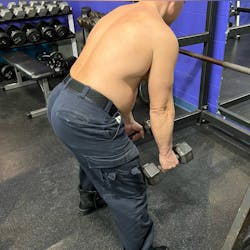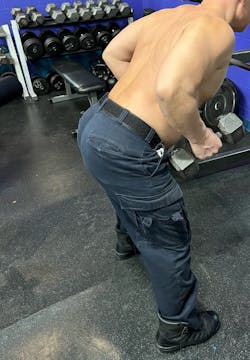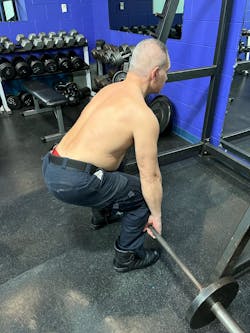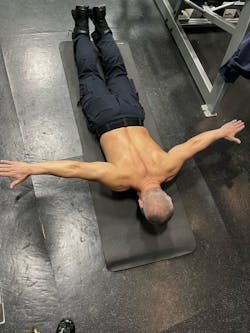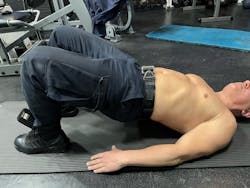Health & Wellness: A Firefighter’s Experience, A Cadet’s Fitness
A Firefighter’s Prayer
“When I am called to duty, God, wherever flames may rage,
Give me the strength to save a life, whatever be its age.
Help me to embrace a little child before it’s too late,
Or save an older person from the horror of that fate.
Enable me to be alert to hear the weakest shout,
And quickly and efficiently to put the fire out.
I want to fill my calling and to give the best in me,
To guard my neighbor and protect his property.
And if according to your will I have to lose my life,
Bless with your protecting hand my loving family from strife.”
Firefighter A.W. “Smokey” Linn wrote this famous prayer after working at a structure fire in which three children were trapped. The responding firefighters could see the children but weren’t able to rescue them, because security bars covered the windows.
Maybe you responded to a fire that’s similar to the one that inspired the prayer, but it’s likely that one or more factors differentiated yours from it. This exemplifies the fact that firefighters don’t know what type of emergency awaits when they arrive at work each day: a fire, a motor vehicle accident, a water rescue, etc. Each time that the tones go off, firefighters are called to protect life and property. The prayer communicates the desire to have the bravery, knowledge, and strength to serve and protect.
How are you preparing for emergency responses?
While attending the fire academy, recruits’ schedule often includes designated time for fitness training in addition to training for firefighter-specific skills and drills to prepare for the physical requirements of the job. After graduation, firefighters continue to have job-specific trainings. However, what happens to efforts to maintain and improve physical fitness?
Tactical fitness
Firefighters are among a group of individuals who are referred to as tactical athletes, who have a high level of required fitness and work to serve and protect. Tactical fitness is different from traditional fitness. Tactical fitness should encompass specific exercises to react quickly in stressful situations and to work as part of a team each day. The tactical athlete must focus on all of the components of fitness, including agility, cardiovascular endurance, coordination, fine motor control, flexibility, muscle strength, power and speed. These all must be utilized in combination and without hesitancy.
Traditional fitness programs have a heavier focus on a few detailed aspects of strength and conditioning.
Wellness programs for firefighters should identify and address specific weaknesses but also play off of an individual’s strengths to train the body as a whole.
Exercise after the academy
Prior to beginning any exercise or fitness program, you should receive medical clearance from a qualified healthcare professional. It also is important to consider your prior activity level, previous or current injuries, current pain and individualized health goals.
Standard operating procedures (SOPs) are utilized in the fire service. Relative to tactical fitness, SOPs should dictate the importance of setting aside time for exercise. Although each firefighter’s SOPs should serve as a guideline, no two are exactly the same.
Shiftwork is highly variable, and it’s important to balance work schedule and appropriate exercise programs. You shouldn’t complete taxing, strenuous exercises before you start a shift. Muscles require sufficient time and resources to recover after such a workout. Otherwise, you might put yourself and others at risk for injury.
When you are on shift, your workout should be geared toward expanding flexibility and involve low-impact activities. When you aren’t at work, a workout can focus on higher-impact exercises.
The more variety that you include in a tactical fitness program, the greater benefit that you will receive. The body responds better and makes greater gains when you complete different exercises. Completing the same workout repeatedly will result in a plateau of your strength and endurance.
Remember to focus on different muscle groups when you work out. Traditional gym-based workouts are valuable, but don’t be afraid to incorporate different activities and nontraditional exercises into your fitness program. These activities include martial arts, mountain biking, Pilates, swimming and yoga.
Four exercises
Although state-of-the-art gym equipment is nice to have, it isn’t necessary to meet your fitness needs. Use what’s available to you. That might be a towel on the floor, the empty apparatus bay, rope, a sledgehammer or even a Halligan. Be creative in your movement patterns and exercises.
Below are some exercises that you can incorporate into your routine, using simple pieces of gym equipment.
Bent-over rows. This exercise may be completed with dumbbells or a barbell. In the case of dumbbells, hold one dumbbell in each hand. While standing, position your feet approximately hip-width apart. Keep your back straight, and bend forward at both hips, approximately 45 degrees. The knees also are slightly bent. Arms should remain about shoulder-width apart and in front of your thighs. Elbows start straight and shoulder blades should be apart.Next, bend your elbows back, keeping the arms close to the body. As the elbows bend, squeeze both shoulder blades back toward each other without arching your spine. Hold this position for about three seconds. Slowly return to the starting position and repeat.
Movement only should occur at the arms and shoulder blades. Don’t strain the neck, arch the back, move the spine or rotate the pelvis.
Deadlifts. This exercise may be completed with dumbbells, a barbell or a hex bar. In the case of a barbell, load the barbell with an appropriate weight. Step up to the bar, keeping the bar as close to your shins as possible. Place your feet a little wider than hip-width apart and keep your back straight throughout the exercise.Squat down to grab the barbell with your hands just outside of your legs and keep your palms facing you. Pull the weight off of the floor, keeping the bar as close to your body as possible. Finish the exercise in a standing position, with the weight at thigh-level.
Slowly lower the barbell to the floor. While you do this, continue to maintain a straight back. Once the weight touches the floor, repeat the exercise.
Supermans. Start by lying face down on a firm surface with your legs out straight. Bring both arms 90 degrees out to the side to form a T position, with your palms facing the floor. At the same time, contract your gluteus muscles and abdominals. To do this, squeeze your buttocks together to isolate the gluteus muscles. The abdominals can be activated by squeezing your stomach muscles together and trying to bring your bellybutton toward your spine.Next, in unison, lift your head, chest, arms and legs off of the floor. The head and neck should be kept in a neutral position. Maintain your arms out to the side and squeeze your shoulder blades backward toward each other. Hold this position for 5–10 seconds, relax and repeat.
Bridges. Lie on your back with your arms by your sides. Bend your knees, keeping your feet and knees both hip-width apart. Contract your gluteus muscles by squeezing your buttocks together. Maintain this muscle contraction throughout the exercise.Keeping your head and neck relaxed, slowly lift your hips off of the ground to create a straight, diagonal line from the knees to the shoulders. Hold this position for 3–5 seconds. Slowly lower your hips and repeat.
Variety
The number of sets and repetitions that you complete for each exercise depends on the goal of your workout. To increase muscle strength, complete two to six sets, with no more than six repetitions per set. To achieve muscle hypertrophy, complete three to six sets of an exercise, with 6–12 repetitions per set. You achieve muscle endurance by completing two to three sets of an exercise, with 12 or more repetitions per set.
No exercise or program should ever cause pain. Exercises might cause fatigue, and stretching is uncomfortable, but those are different than pain. If you experience pain, you might benefit from evaluation and treatment from a medical professional.
Create fitness SOPs
Maintaining and improving fitness is a part of firefighter health and wellness. That said, whether you’re a recent graduate or a veteran, whether you’re new to training or have been active for years, it’s important not to progress exercises too quickly. Increasing the amount of weight that’s lifted, the frequency of exercises or the duration of the activity too quickly can increase the risk of injury.
Firefighter A.W. “Smokey” Linn wrote this famous prayer after working at a structure fire in which three children were trapped. The responding firefighters could see the children but weren’t able to rescue them, because security bars covered the windows.
Maybe you responded to a fire that’s similar to the one that inspired the prayer, but it’s likely that one or more factors differentiated yours from it. This exemplifies the fact that firefighters don’t know what type of emergency awaits when they arrive at work each day: a fire, a motor vehicle accident, a water rescue, etc. Each time that the tones go off, firefighters are called to protect life and property. The prayer communicates the desire to have the bravery, knowledge, and strength to serve and protect.
How are you preparing for emergency responses?
While attending the fire academy, recruits often have designated time for fitness training in addition to training for firefighter-specific skills and drills to prepare for the physical requirements of the job. After graduation, firefighters continue to have job-specific trainings. However, what happens to maintaining and improving physical fitness?
Tactical fitness
Firefighters are among a group of individuals who are referred to as tactical athletes, who have a high level of required fitness and work to serve and protect. Tactical fitness is different from traditional fitness. Tactical fitness should encompass specific exercises to react quickly in stressful situations and to work as part of a team each day. The tactical athlete must focus on all of the components of fitness, including agility, cardiovascular endurance, coordination, fine motor control, flexibility, muscle strength, power and speed. These all must be utilized in combination and without hesitancy.
Traditional fitness programs have a heavier focus on a few detailed aspects of strength and conditioning.
Wellness programs for firefighters should identify and address specific weaknesses but also play off of an individual’s strengths to train the body as a whole.
Exercise after the academy
Prior to beginning any exercise or fitness program, you should receive medical clearance from a qualified healthcare professional. It also is important to consider your prior activity level, previous or current injuries, current pain and individualized health goals.
Standard operating procedures (SOPs) are utilized in the fire service. Relative to tactical fitness, SOPs should dictate the importance of setting aside time for exercise. Although each firefighter’s SOPs should serve as a guideline, no two are exactly the same.
Shiftwork is highly variable, and it’s important to balance work schedule and appropriate exercise programs. You shouldn’t complete taxing, strenuous exercises before you start a shift. Muscles require sufficient time and resources to recover after such a workout. Otherwise, you might put yourself and others at risk for injury.
When you are on shift, your workout should be geared toward flexibility and low-impact activities. When you aren’t at work, a workout can focus on higher-impact exercises.
The more variety that you include in a tactical fitness program, the greater benefit that you will receive. The body responds better and makes greater gains when you complete different exercises. Completing the same workout repeatedly will result in a plateau of your strength and endurance.
Remember to focus on different muscle groups. Traditional gym-based workouts are valuable, but don’t be afraid to incorporate different activities and nontraditional exercises into your fitness program. These activities include martial arts, mountain biking, Pilates, swimming and yoga.
Four exercises
Although state-of-the-art gym equipment is nice to have, it isn’t necessary to meet your fitness needs. Use what’s available to you. That might be a towel on the floor, the empty apparatus bay, rope, a sledgehammer or even a Halligan. Be creative in your movement patterns and exercises.
Below are some exercises that you can incorporate into your routine, using a simple pieces of gym equipment.
Bent-over rows. This exercise may be completed with dumbbells or a barbell. In the case of dumbbells, hold one dumbbell in each hand. While standing, position your feet approximately hip-width apart. Keep your back straight, and bend forward at both hips, approximately 45 degrees. The knees also are slightly bent. Arms should remain about shoulder-width apart and in front of your thighs. Elbows start straight and shoulder blades should be apart.
Next, bend your elbows back, keeping the arms close to the body. As the elbows bend, squeeze both shoulder blades back toward each other without arching your spine. Hold this position for about three seconds. Slowly return to the starting position and repeat.
Movement only should occur at the arms and shoulder blades. Don’t strain the neck, arch the back, move the spine or rotate the pelvis.
Deadlifts. This exercise may be completed with dumbbells, a barbell or a hex bar. In the case of a barbell, load the barbell with an appropriate weight. Step up to the bar, keeping the bar as close to your shins as possible. Place your feet a little wider than hip-width apart and keep your back straight throughout the exercise.
Squat down to grab the barbell with your hands just outside of your legs and keep your palms facing you. Pull the weight off of the floor, keeping the bar as close to your body as possible. Finish the exercise in a standing position, with the weight at thigh-level.
Slowly lower the barbell to the floor, continuing to maintain a straight back. Once the weight touches the floor, repeat the exercise.
Supermans. Start by lying face down on a firm surface with your legs out straight. Bring both arms 90 degrees out to the side to form a T position, with your palms facing the floor. At the same time, contract your gluteus muscles and abdominals. To do this, squeeze your buttocks together to isolate the gluteus muscles. The abdominals can be activated by squeezing your stomach muscles together and trying to bring your bellybutton toward your spine.
Next, in unison, lift your head, chest, arms and legs off of the floor. The head and neck should be kept in a neutral position. Maintain your arms out to the side and squeeze your shoulder blades backward toward each other. Hold this position for 5–10 seconds, relax and repeat.
Bridges. Lie on your back with your arms by your sides. Bend your knees, keeping your feet and knees both hip-width apart. Contract your gluteus muscles by squeezing your buttocks together. Maintain this muscle contraction throughout the exercise.
Keeping your head and neck relaxed, slowly lift your hips off of the ground to create a straight, diagonal line from the knees to the shoulders. Hold this position for 3–5 seconds. Slowly lower your hips and repeat.
Variety
The number of sets and repetitions that you complete for each exercise depends on the goal of your workout. To increase muscle strength, complete two to six sets, with no more than six repetitions per set. To achieve muscle hypertrophy, complete three to six sets of an exercise, with 6–12 repetitions per set. You achieve muscle endurance by completing two to three sets of an exercise, with 12 or more repetitions per set.
No exercise or program should ever cause pain. Exercises might cause fatigue, and stretching is uncomfortable, but those are different than pain. If you experience pain, you might benefit from evaluation and treatment from a medical professional.
Create fitness SOPs
Maintaining and improving fitness is a part of firefighter health and wellness. That said, whether you’re a recent graduate or a veteran, whether you’re new to training or have been active for years, it’s important not to progress exercises too quickly. Increasing the amount of weight that’s lifted, the frequency of exercises or the duration of the activity too quickly can increase the risk of injury.

Jessica Scott
Jessica Scott is a Doctor of physical therapy, a certified athletic trainer, and a tactical strength and conditioning facilitator. She received her undergraduate degree in athletic training and sports medicine and her Doctorate of physical therapy from Quinnipiac University. As the daughter of a firefighter, Scott grew up seeing the physical demands and requirements of the firefighting profession. Therefore, she started New England Tactical Sports Medicine, which is dedicated to improving the health and wellness of tactical athletes and provides rehabilitation services, educational seminars regarding injury prevention, and fitness programs to promote healthy lifestyles and improved physical performance.
